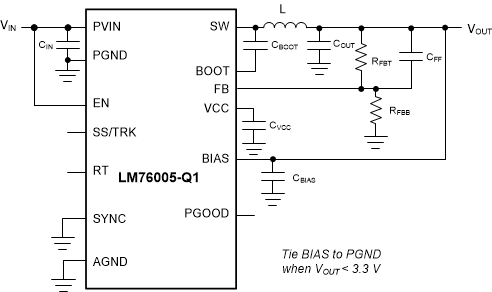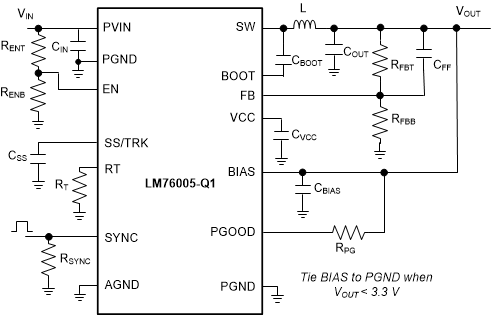ZHCSKV2A February 2020 – July 2020 LM76005-Q1
PRODUCTION DATA
- 1 特性
- 2 应用
- 3 说明
- 4 Revision History
- 5 Pin Configuration and Functions
- 6 Specifications
-
7 Detailed Description
- 7.1 Overview
- 7.2 Functional Block Diagram
- 7.3
Feature Description
- 7.3.1 Fixed-Frequency, Peak-Current-Mode Control
- 7.3.2 Light Load Operation Modes — PFM and FPWM
- 7.3.3 Adjustable Output Voltage
- 7.3.4 Enable (EN Pin) and UVLO
- 7.3.5 Internal LDO, VCC UVLO, and Bias Input
- 7.3.6 Soft Start and Voltage Tracking (SS/TRK)
- 7.3.7 Adjustable Switching Frequency (RT) and Frequency Synchronization
- 7.3.8 Minimum On-Time, Minimum Off-Time, and Frequency Foldback at Dropout Conditions
- 7.3.9 Bootstrap Voltage and VBOOT UVLO (BOOT Pin)
- 7.3.10 Power Good and Overvoltage Protection (PGOOD)
- 7.3.11 Overcurrent and Short-Circuit Protection
- 7.3.12 Thermal Shutdown
- 7.4 Device Functional Modes
-
8 Application and Implementation
- 8.1 Application Information
- 8.2
Typical Applications
- 8.2.1 Design Requirements
- 8.2.2
Detailed Design Procedure
- 8.2.2.1 Custom Design With WEBENCH® Tools
- 8.2.2.2 Output Voltage Setpoint
- 8.2.2.3 Switching Frequency
- 8.2.2.4 Input Capacitors
- 8.2.2.5 Inductor Selection
- 8.2.2.6 Output Capacitor Selection
- 8.2.2.7 Feedforward Capacitor
- 8.2.2.8 Bootstrap Capacitors
- 8.2.2.9 VCC Capacitors
- 8.2.2.10 BIAS Capacitors
- 8.2.2.11 Soft-Start Capacitors
- 8.2.2.12 Undervoltage Lockout Setpoint
- 8.2.2.13 PGOOD
- 8.2.2.14 Synchronization
- 8.2.3 Application Curves
- 9 Power Supply Recommendations
- 10Layout
- 11Device and Documentation Support
- 12Mechanical, Packaging, and Orderable Information
8.2 Typical Applications
The LM76005-Q1 only requires a few external components to convert from a wide range of supply voltages to output voltage, as shown in Figure 8-1:
 Figure 8-1 LM76005-Q1 Basic Schematic
Figure 8-1 LM76005-Q1 Basic SchematicThe LM76005-Q1 also integrates a full list of features to aid system design requirements, such as the following:
- VCC UVLO
- Programmable soft start
- Start-up tracking
- Programmable switching frequency
- Clock synchronization
- Power-good indication
Each system can select the features needed in a specific application. A comprehensive schematic with all features utilized is shown in Figure 8-2:
 Figure 8-2 LM76005-Q1 Comprehensive Schematic
Figure 8-2 LM76005-Q1 Comprehensive SchematicThe external components must fulfill the requirements of the application, but also the stability criteria of the device control loop. The LM76005-Q1 is optimized to work within a range of external components. Inductance and capacitance of the LC output filter each create poles that have to be considered in the control of the converter. For VOUT = 1 V, 3.3 V, 5V, the recommended output capacitors have been generated assuming typical derating for 16-V, X7R, automotive grade capacitors. For VOUT = 12 V, the recommended output capacitors have been generated assuming typical derating for 25-V, X7R, automotive grade capacitors, and for VOUT = 24 V, the recommended output capacitors have been generated assuming typical derating for 50-V, X7R, automotive grade capacitors. If lower voltage, nonautomotive grade, or lower temperature rated capacitors are used, more capacitors than listed are likely to be needed.Table 8-1 can be used to simplify the output filter component selection.
| fSW (kHz) | VOUT (V) | L (µH) | COUT (µF) | RFBT (kΩ) | RFBB (kΩ) |
|---|---|---|---|---|---|
| 200 | 1 | 2.5 | 720 | 100 | OPEN |
| 400 | 1 | 1.2 | 600 | 100 | OPEN |
| 500 | 1 | 1 | 470 | 100 | OPEN |
| 200 | 3.3 | 10 | 300 | 100 | 43.5 |
| 400 | 3.3 | 4.7 | 220 | 100 | 43.5 |
| 500 | 3.3 | 4.7 | 200 | 100 | 43.5 |
| 200 | 5 | 15 | 250 | 100 | 25 |
| 400 | 5 | 6.8 | 180 | 100 | 25 |
| 500 | 5 | 5.2 | 150 | 100 | 25 |
| 200 | 12 | 22 | 200 | 100 | 9.09 |
| 400 | 12 | 10 | 150 | 100 | 9.09 |
| 500 | 12 | 7.2 | 120 | 100 | 9.09 |
| 200 | 24 | 44 | 150 | 100 | 4.37 |
| 400 | 24 | 22 | 100 | 100 | 4.37 |
| 500 | 24 | 15 | 88 | 100 | 4.37 |